Viscoelastic Numerical Simulation Study on the Co-Extrusion Process of Tri-Composite Tire Tread
Abstract
:1. Introduction
2. Numerical Simulation Model
2.1. Mathematical Model
- continuity equation
- momentum equation
2.2. Constitutive Model and Parameters
2.3. Geometry Model and Mesh Division
2.4. Flow Boundary Conditions
- 1.
- Inlet: the total inlet volume flow rate is Q, and the flow is fully developed.
- 2.
- Wall: Generalized Navier’s law [19] was adopted to characterize the slip of the rubber melt at the wall, as shown in Equation (4) below:Here, F(v) is the wall slip resistance; k is the slip coefficient, taking the value of ; e is a dimensionless number; v is the velocity of rubber melt at the wall surface.
- 3.
- Interface: Surface tension is neglected, and there is no slip at the interface. Dynamic conditions: ; Kinematic conditions: .
- 4.
- Free surface: Dynamic conditions: ; Kinematic conditions: .
- 5.
- Symmetry plane: Dynamic conditions: ; Kinematic conditions: .
- 6.
- Outlet: Setting traction speed vz.
2.5. Calculation Strategy
3. Results and Discussion
3.1. Model Verification
3.2. Die Swell Analysis
3.3. Co-Extrusion Influencing Factors
3.3.1. Process Parameters
3.3.2. Die Structure
4. Conclusions
- 1.
- The size error of the extruded tread profile between simulation and experiment is less than 6%, which indicates that the numerical simulation technology can be used to predict the profile of the extruded tread, provide theoretical guidance for the structural design of the die thus improve the efficiency of the die design.
- 2.
- The difference between the rubber’s rheological properties and the die structure makes the die swelling process and flow characteristics of the three rubbers quite different. Therefore, it is necessary to reasonably design the die structure to prevent the rubber melt’s poor fluidity and excessive flow fluctuation.
- 3.
- The die swell rate is directly proportional to the inflow rate and inversely proportional to the traction speed. Increasing the inflow rate will lead to a decrease in the uniformity of rubber flow and the surface quality of the extruded tread, so it is necessary to control the inflow rate within a reasonable range. Die structure has little effect on the extruded tread profile, and increasing the die thickness can moderately improve the flow uniformity of the rubber compound and the surface quality of the extruded tread. However, increasing the convergence angle of the die will cause the shear rate at the die outlet to increase significantly, resulting in a decrease in the surface quality of the extruded tread and, at the same time, bringing a slight negative impact on the uniformity of the rubber flow. Hence, the die needs to be designed as flat as possible.
Author Contributions
Funding
Institutional Review Board Statement
Informed Consent Statement
Data Availability Statement
Conflicts of Interest
References
- Meyer, H.G. High-Tech Quadroplex Extrusion Technology for the Tire Industry. In Current Topics in Elastomers Research; CRC Press: Boca Raton, FL, USA, 2008; pp. 1013–1018. [Google Scholar]
- Li, J.; Liu, Q.W.; Liu, L.S. Numerical simulation on the whole co-extrusion process of tread rubber. In Applied Mechanics and Materials; Trans Tech Publications Ltd.: Stafa-Zurich, Switzerland, 2015; Volume 723, pp. 878–883. [Google Scholar]
- Borzacchiello, D.; Leriche, E.; Blottière, B.; Guillet, J. Three-dimensional finite volume computation of viscoelastic fluid encapsulation by phase-field modeling. J. Non-Newton. Fluid Mech. 2013, 200, 52–64. [Google Scholar] [CrossRef]
- Elgeti, S.; Probst, M.; Windeck, C.; Behr, M.; Michaeli, W.; Hopmann, C. Numerical shape optimization as an approach to extrusion die design. Finite Elem. Anal. Des. 2012, 61, 35–43. [Google Scholar] [CrossRef]
- Takase, M.; Kihara, S.I.; Funatsu, K. Three-dimensional viscoelastic numerical analysis of the encapsulation phenomena in coextrusion. Rheol. Acta 1998, 37, 624–634. [Google Scholar] [CrossRef]
- Anderson, P.D.; Dooley, J.; Meijer, H.E. Viscoelastic effects in multilayer polymer extrusion. Appl. Rheol. 2006, 16, 198–205. [Google Scholar] [CrossRef]
- Sharma, S.; Goswami, M.; Deb, A.; Padhan, B.; Chattopadhyay, S. Structural deformation/instability of the co-extrudate rubber profiles due to die swell: Experimental and CFD studies with 3D models. Chem. Eng. J. 2021, 424, 130504. [Google Scholar] [CrossRef]
- Liang, J.Z. Effect of the die angle on the extrusion swell of rubber compound. J. Mater. Process. Technol. 1995, 52, 207–212. [Google Scholar] [CrossRef]
- Sunwoo, K.B.; Park, S.J.; Lee, S.J.; Ahn, K.H.; Lee, S.J. Numerical simulation of three-dimensional viscoelastic flow using the open boundary condition method in coextrusion process. J. Non-Newton. Fluid Mech. 2001, 99, 125–144. [Google Scholar] [CrossRef]
- Liu, H.; Deng, X.; Huang, Y.; Huang, X.; Li, M. Three-dimensional viscoelastic simulation of the effect of wall slip on encapsulation in the coextrusion process. J. Polym. Eng. 2013, 33, 625–632. [Google Scholar] [CrossRef]
- Zhao, F.; Shi, X.; Chen, X.; Zhao, S. Interaction of Vulcanization and Reinforcement of CB on Dynamic Property of NR Characterized by RPA2000. J. Appl. Polym. Sci. 2010, 117, 1168–1172. [Google Scholar] [CrossRef]
- Dhinakaran, S.; Afonso, A.M.; Alves, M.A.; Pinho, F.T. Steady viscoelastic fluid flow between parallel plates under electro-osmotic forces: Phan-Thien–Tanner model. J. Colloid Interface Sci. 2010, 344, 513–520. [Google Scholar] [CrossRef]
- Yurygin, P.P.; Gudanov, I.S.; Lavrent’ev, Y.B.; Dolgin, D.S.; Lebedev, A.E.; Kapranova, A.B. Modeling of Process of CO-Extrusion of Rubber Mixtures in the Channels of Cable Dies. Chem. Pet. Eng. 2020, 56, 504–507. [Google Scholar] [CrossRef]
- Ferrás, L.L.; Morgado, M.L.; Rebelo, M.; McKinley, G.H.; Afonso, A.M. A generalised Phan–Thien—Tanner model. J. Non-Newton. Fluid Mech. 2019, 269, 88–99. [Google Scholar] [CrossRef]
- Tomé, M.F.; Paulo, G.S.D.; Pinho, F.T.; Alves, M.A. Numerical solution of the PTT constitutive equation for unsteady three-dimensional free surface flows. J. Non-Newton. Fluid Mech. 2010, 165, 247–262. [Google Scholar] [CrossRef]
- Yang, J.; Gao, T.; Gui, H.; Guo, J.; Huang, M. Effects of Lactoalbumin Addition to Vulcanized Rubber Determined by RPA2000. In Proceedings of the 2015 4th International Conference on Mechatronics, Materials, Chemistry and Computer Engineering, Xi’an, China, 12–13 December 2015; Atlantis Press: Paris, France, 2015. [Google Scholar]
- Niedźwiedź, W. Rheological Characteristics of TPE Thermoplastic Elastomer. Ph.D. Thesis, Instytut Technik Wytwarzania, Warszawa, Poland, 2018. [Google Scholar]
- Lo, D.S. Finite Element Mesh Generation; CRC Press: Boca Raton, FL, USA, 2014. [Google Scholar]
- Drapaca, C.S. Poiseuille flow of a non-local non-newtonian fluid with wall slip: A first step in modeling cerebral microaneurysms. Fractal Fract. 2018, 2, 9. [Google Scholar] [CrossRef]
- Varchanis, S.; Syrakos, A.; Dimakopoulos, Y.; Tsamopoulos, J. A new finite element formulation for viscoelastic flows: Circumventing simultaneously the LBB condition and the high-Weissenberg number problem. J. Non-Newton. Fluid Mech. 2019, 267, 78–97. [Google Scholar] [CrossRef]
- Aloku, G.O.; Yuan, X.-F. Numerical simulation of polymer foaming process in extrusion flow. Chem. Eng. Sci. 2010, 65, 3749–3761. [Google Scholar] [CrossRef]
- Zhang, G.; Huang, X.; Li, S.; Xia, C.; Deng, T. Improved inverse design method for thin-wall hollow profiled polymer extrusion die based on FEM-CFD simulations. Int. J. Adv. Manuf. Technol. 2020, 106, 2909–2919. [Google Scholar] [CrossRef]
- Wang, T.; Wang, Y.; Zhu, X.; Su, H. Effects of Different Clearance and Inflow rate on the Mixing Characteristics of the Fluid Flow Field of Combined Screws with Tri-Screw Extruder. J. Liaoning Univ. Pet. Chem. Technol. 2017, 37, 46. [Google Scholar]
- Mezi, D.; Ausias, G.; Grohens, Y.; Férec, J. Numerical simulation and modeling of the die swell for fiber suspension flows. J. Non-Newton. Fluid Mech. 2019, 274, 104205. [Google Scholar] [CrossRef]
- Chhabra, R.P.; Richardson, J.F. Non-Newtonian Flow and Applied Rheology: Engineering Applications; Butterworth-Heinemann: Oxford, UK, 2011. [Google Scholar]
- Futamura, S. Effect of material properties on tire performance characteristics—Part II, Tread material. Tire Sci. Technol. 1990, 18, 2–12. [Google Scholar] [CrossRef]
- Huang, J.C.; Leong, K.S. Shear viscosity, extensional viscosity, and die swell of polypropylene in capillary flow with pressure dependency. J. Appl. Polym. Sci. 2002, 84, 1269–1276. [Google Scholar] [CrossRef]
- Hatzikiriakos, S.G. Wall slip of molten polymers. Prog. Polym. Sci. 2012, 37, 624–643. [Google Scholar] [CrossRef]
- El Kissi, N.; Piau, J.M.; Toussaint, F. Sharkskin and cracking of polymer melt extrudates. J. Non-Newton. Fluid Mech. 1997, 68, 271–290. [Google Scholar] [CrossRef]
- Koopmans, R.; Den Doelder, J.; Molenaar, J. Polymer Melt Fracture; CRC Press: Boca Raton, FL, USA, 2010. [Google Scholar]

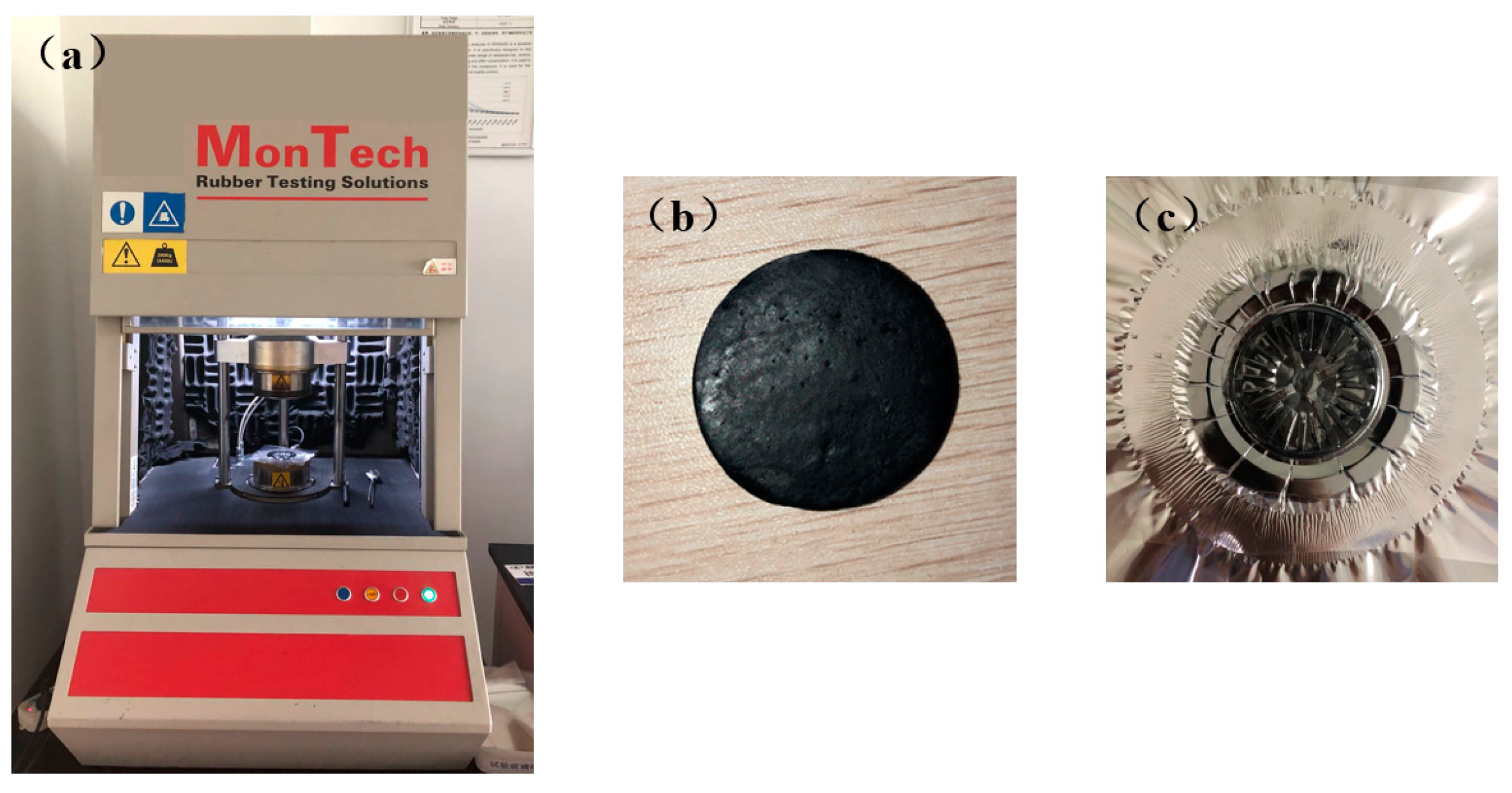
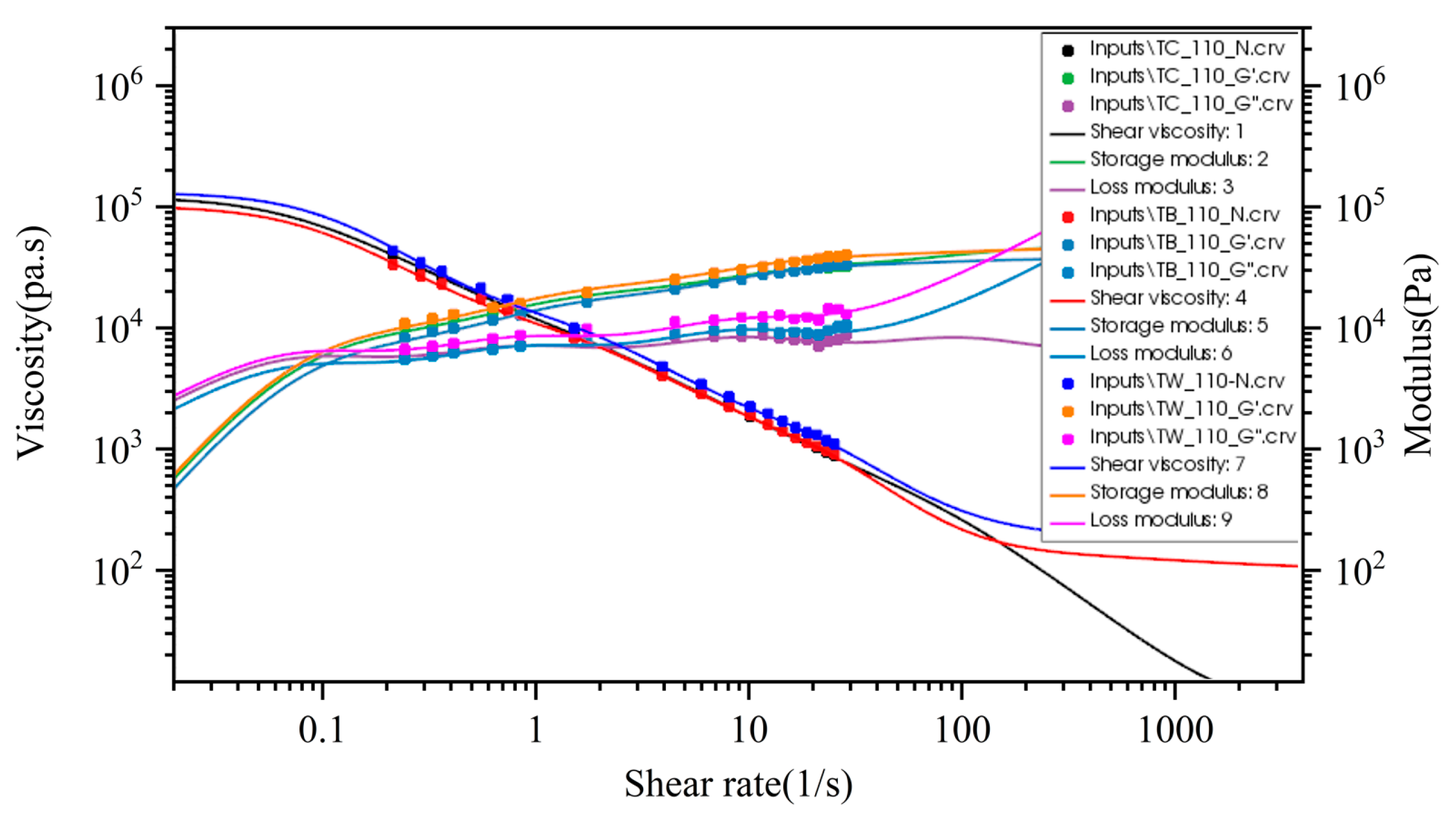


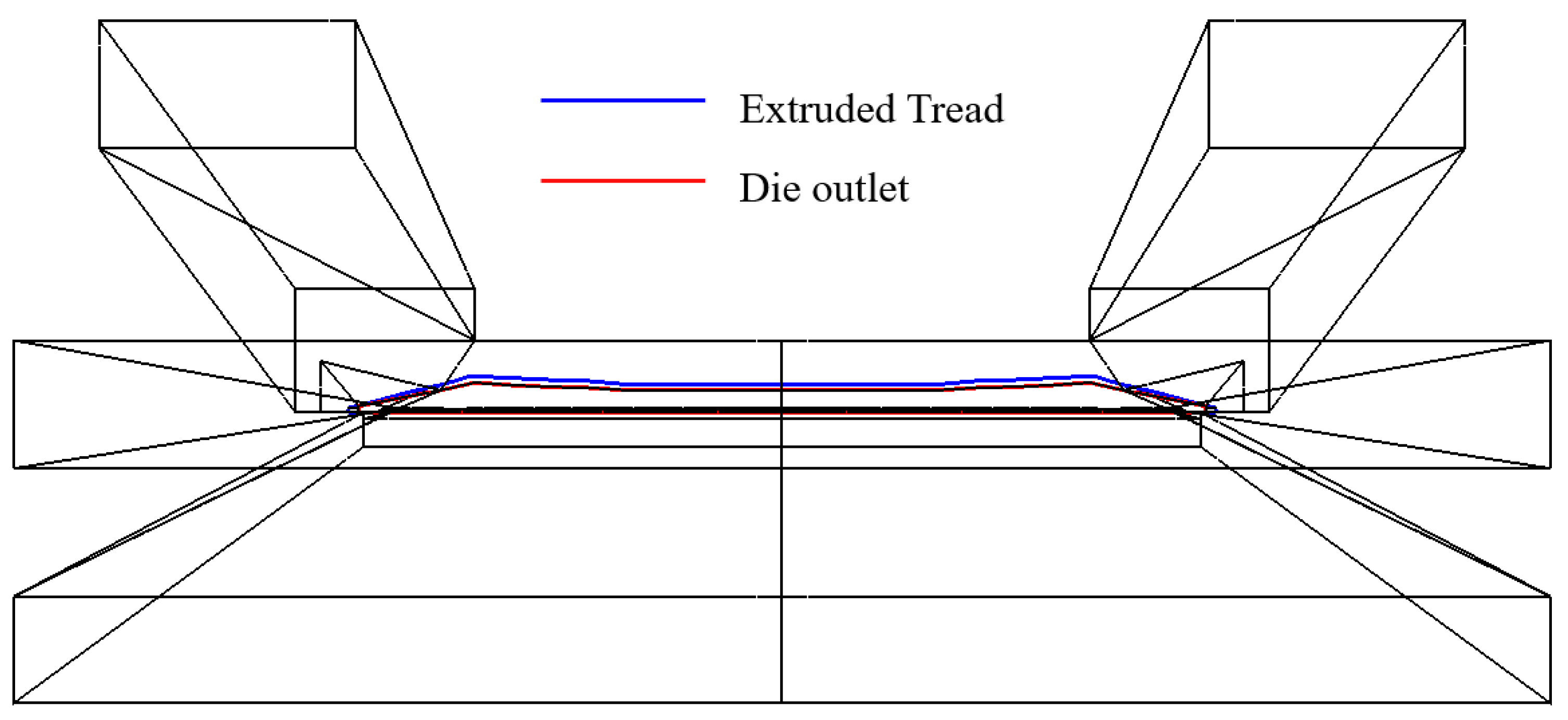


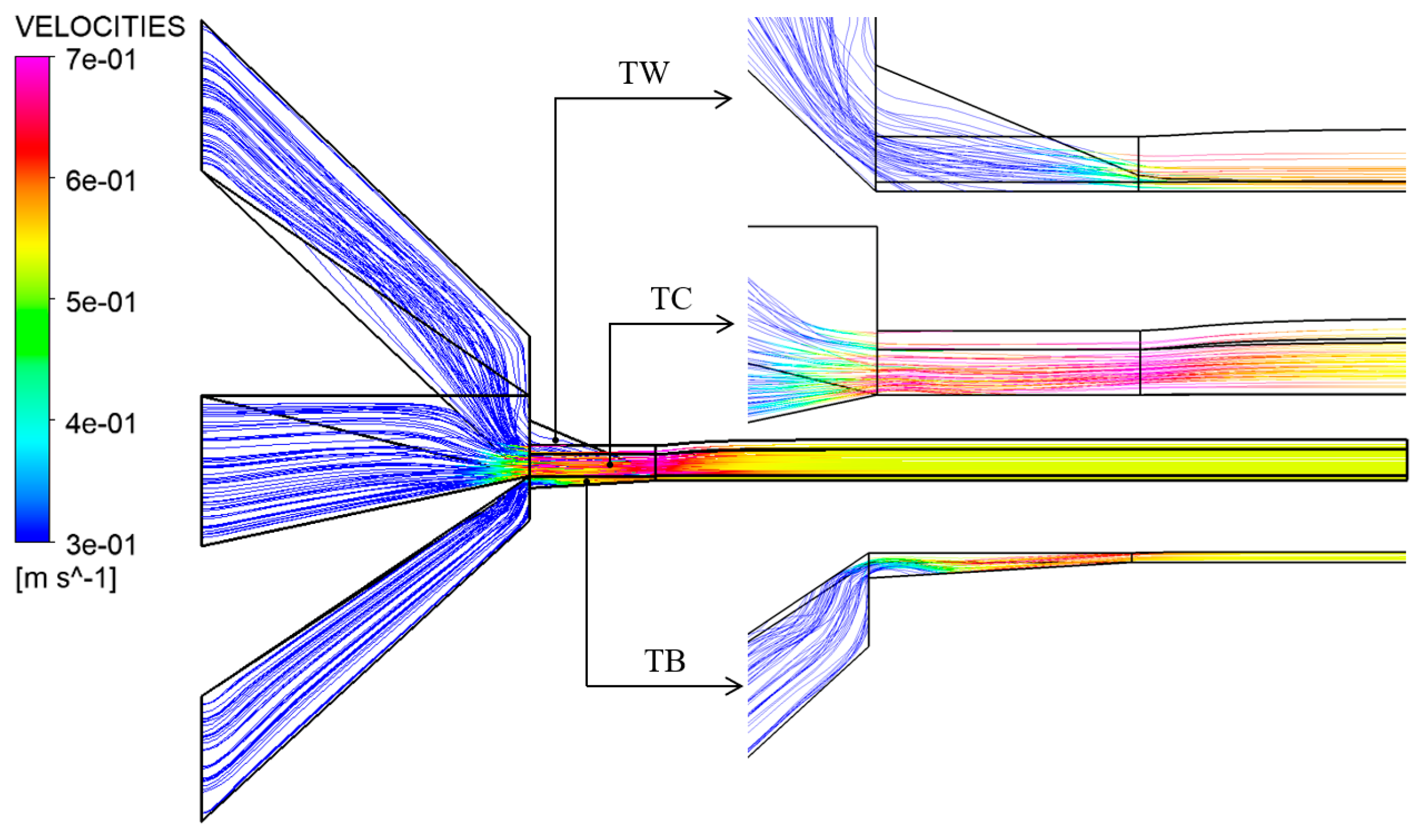


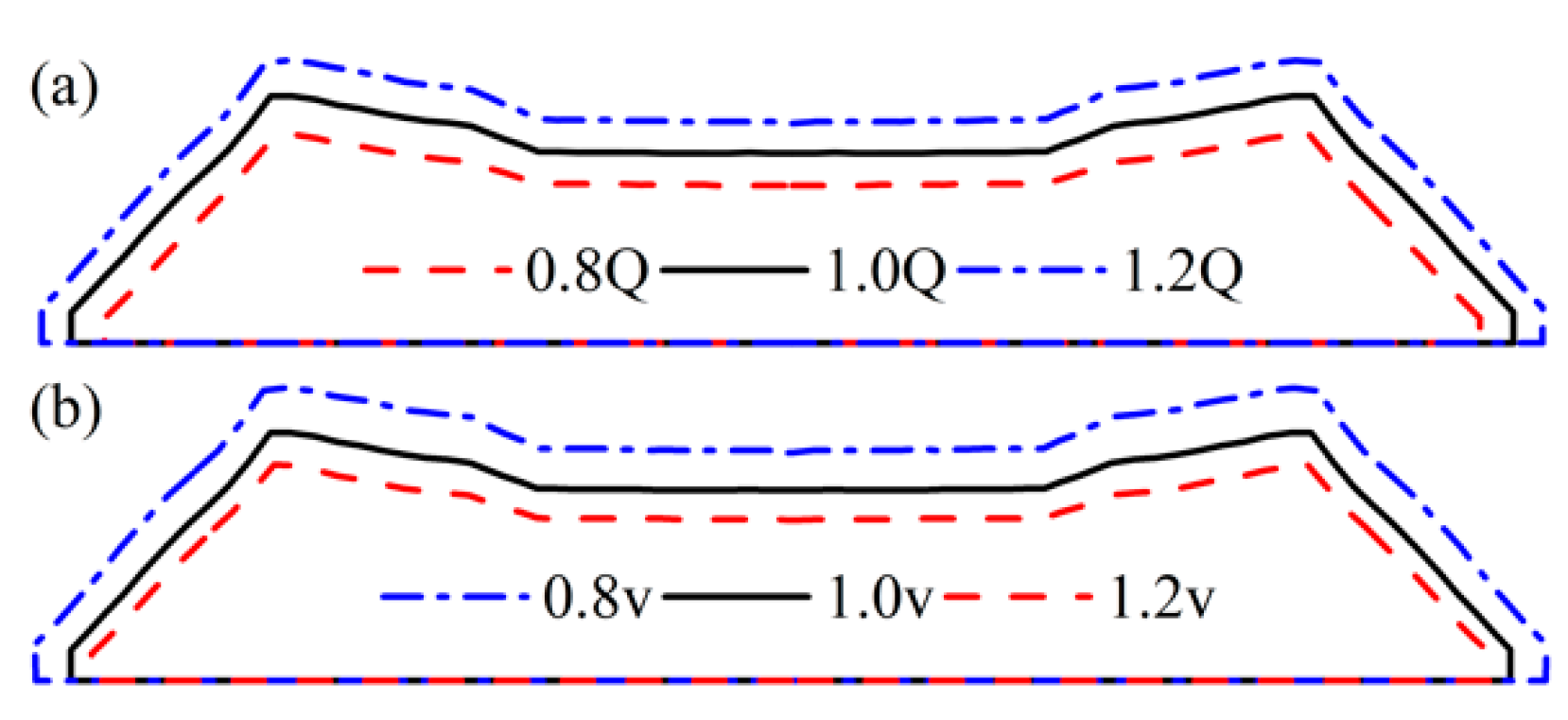
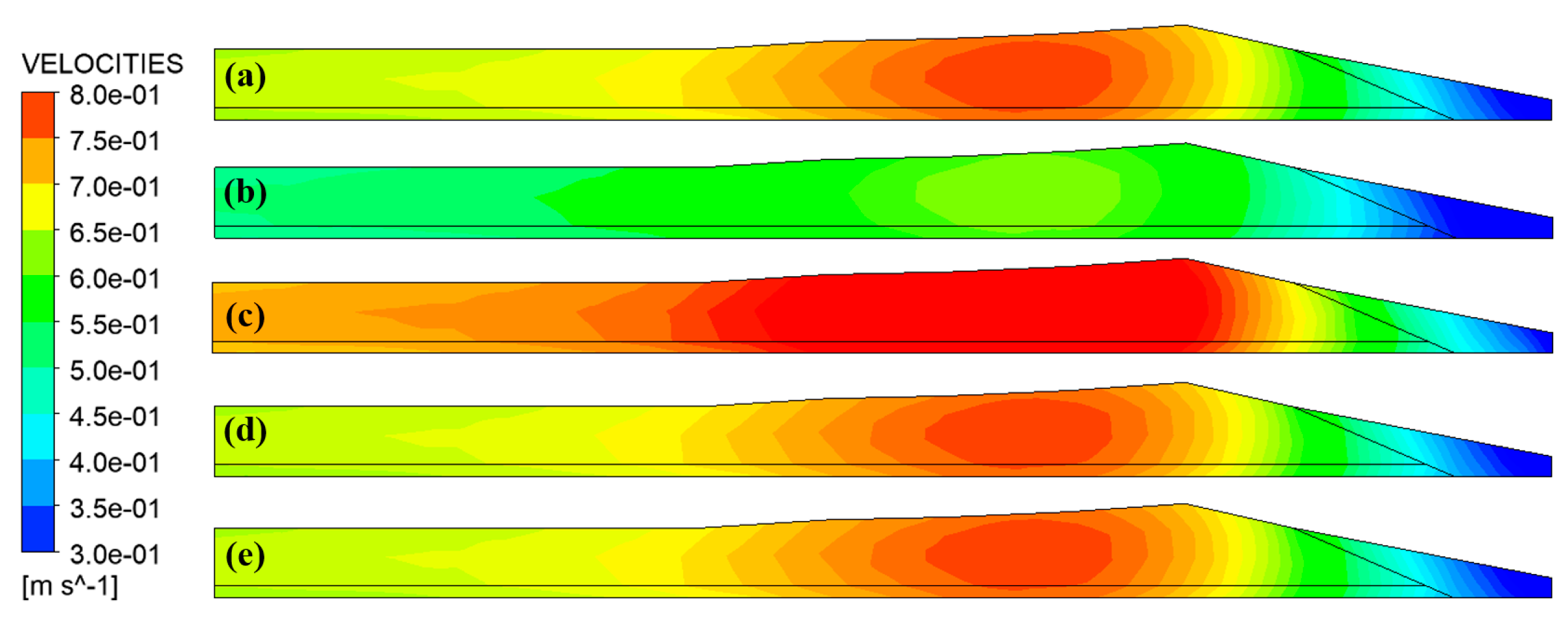
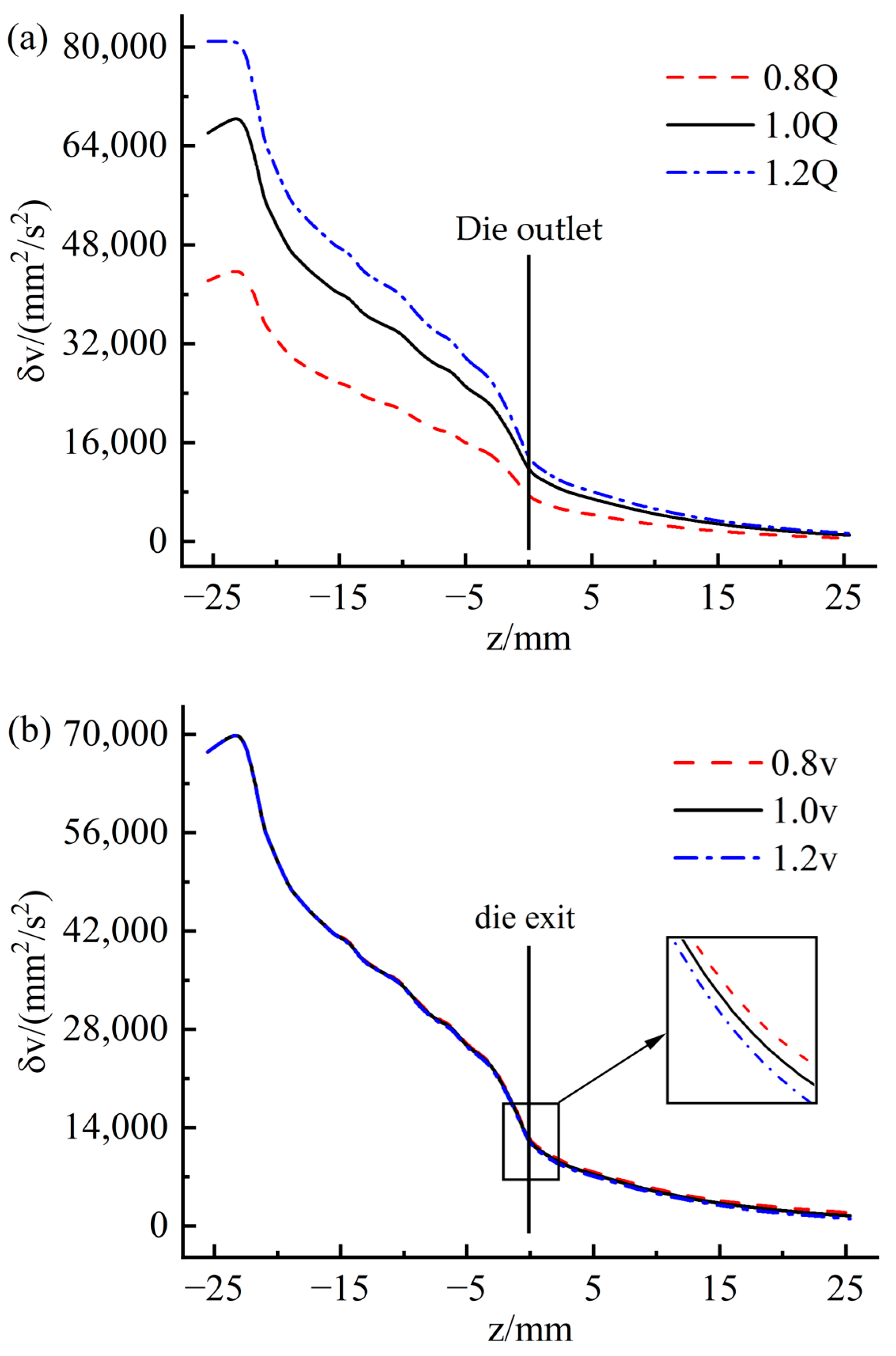
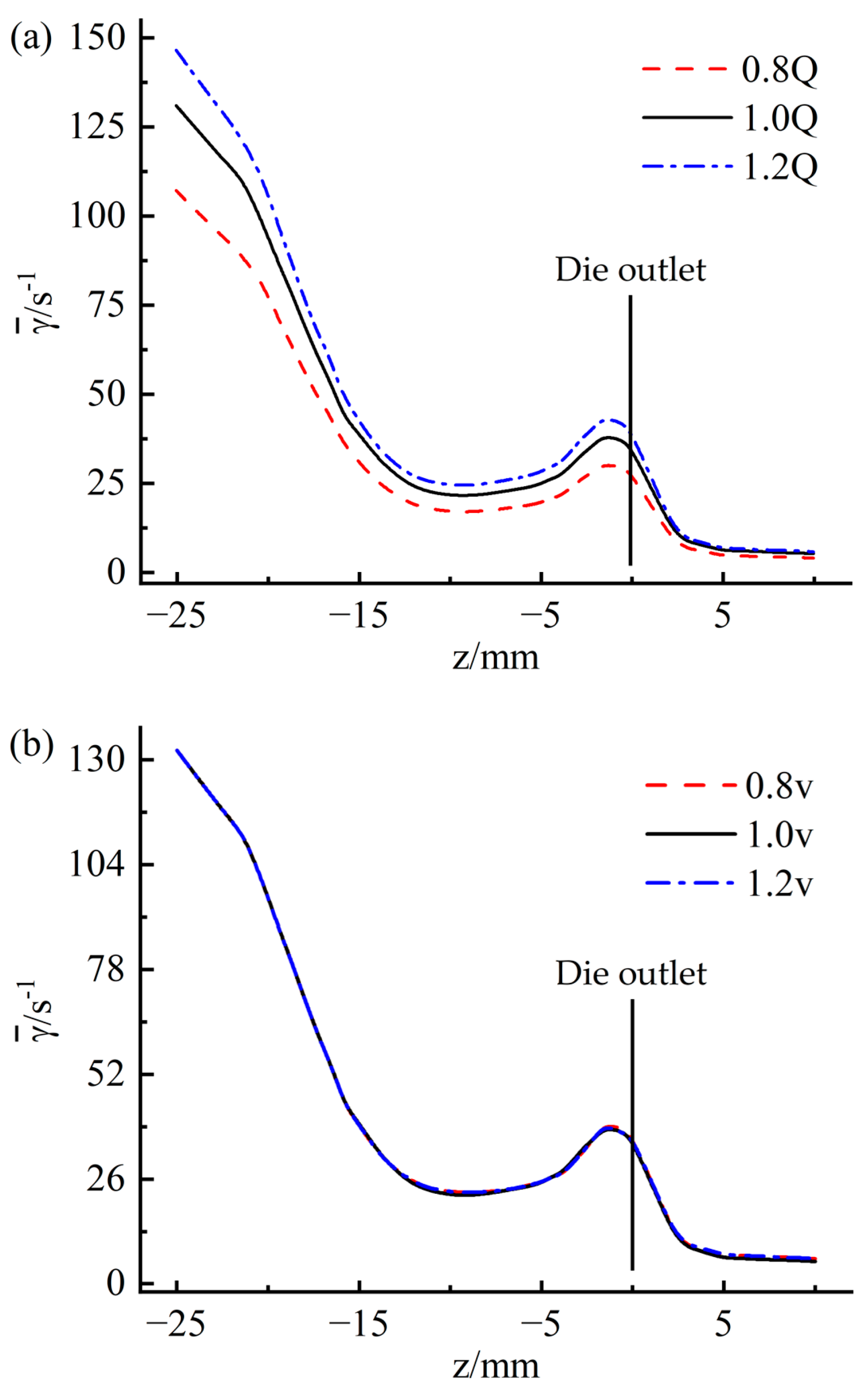

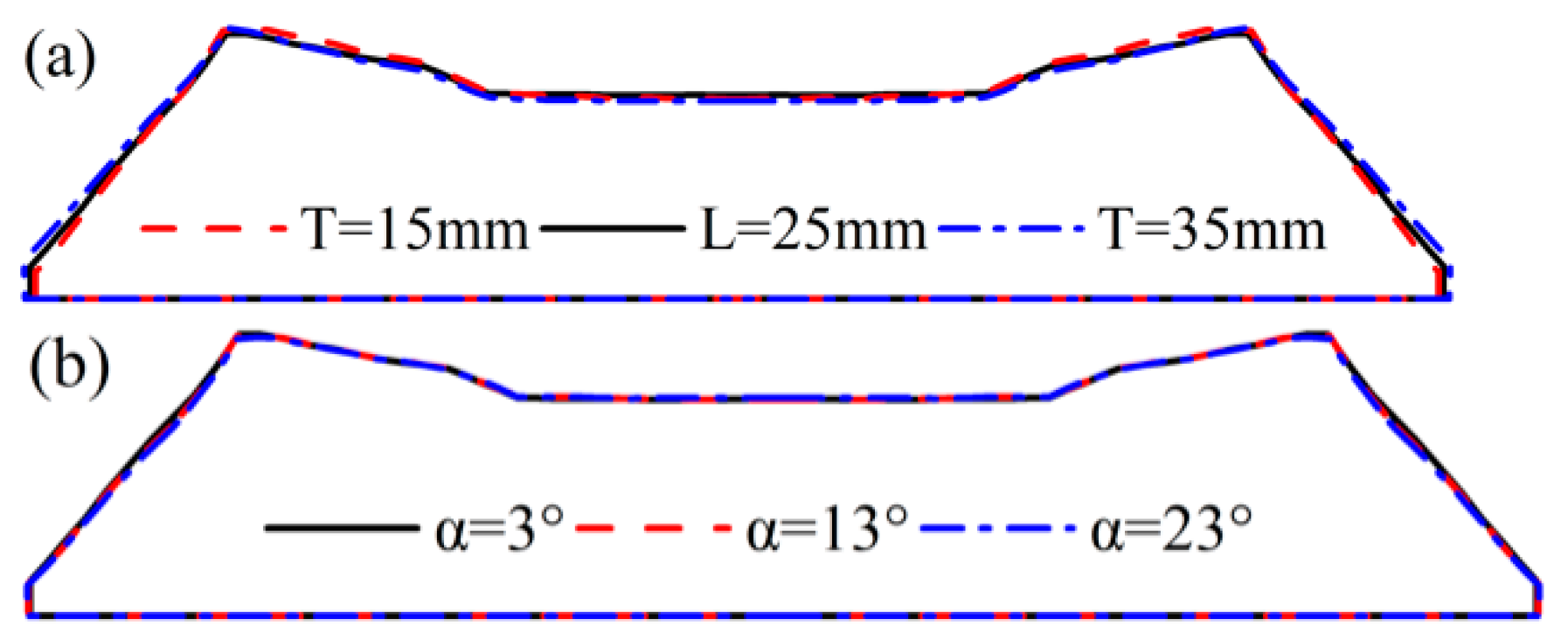

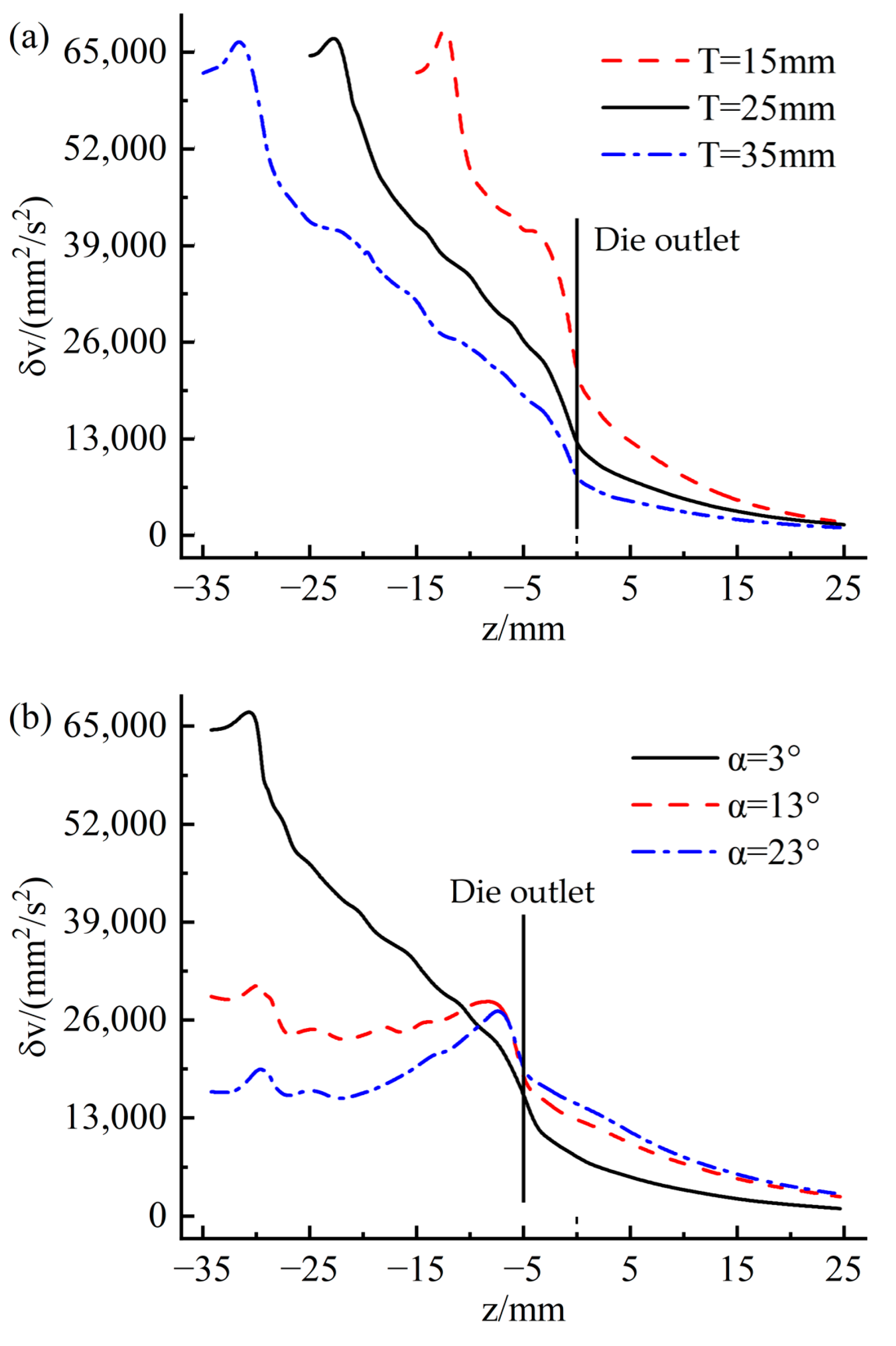
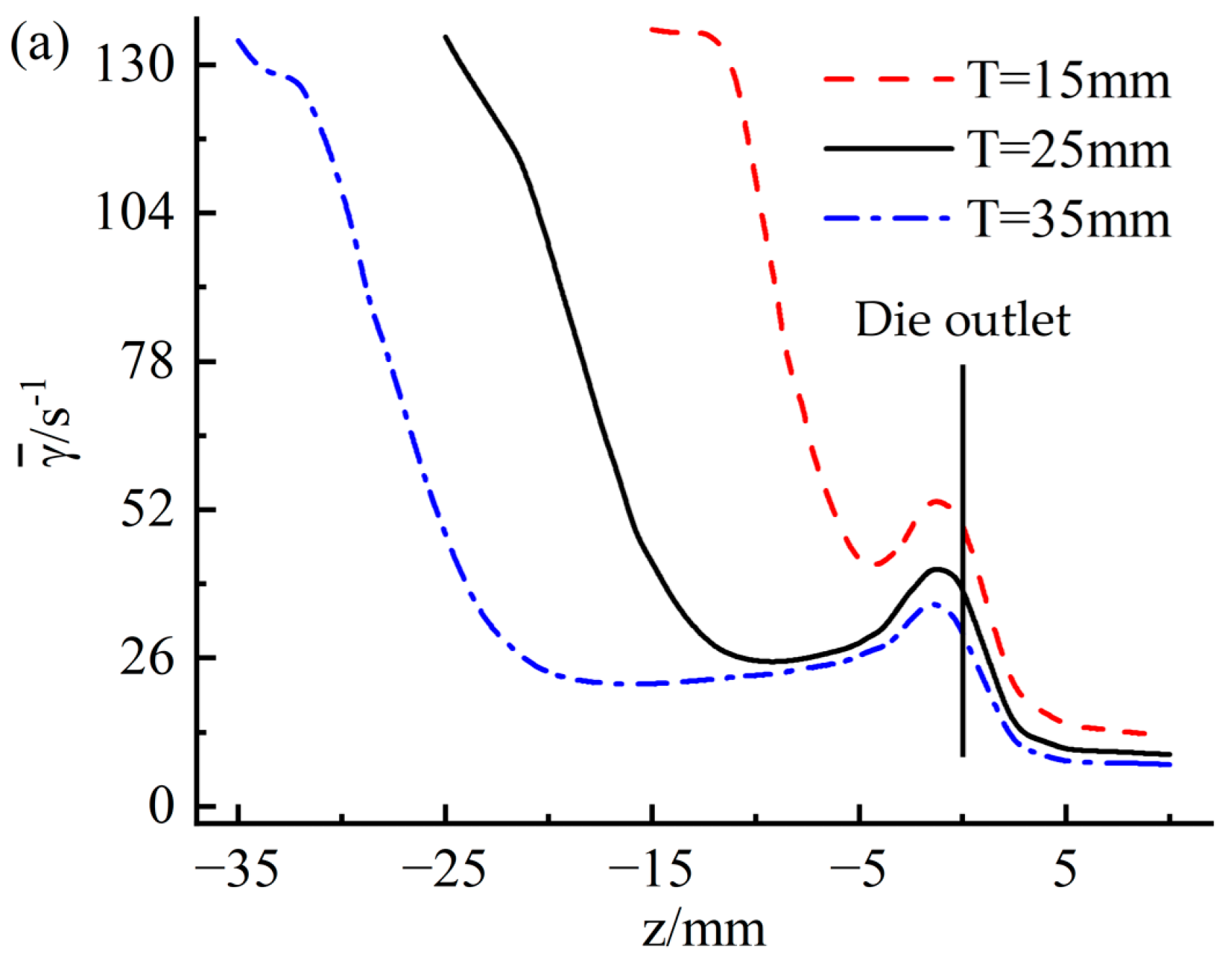

| Rubber | η0/(Pa.s) | λ/s | ε | ξ |
|---|---|---|---|---|
| TC | 142,708 | 10.8 | 0.019 | 0.19 |
| TB | 116,929 | 9.5 | 0.014 | 0.21 |
| TW | 202,837 | 11.6 | 0.022 | 0.14 |
| Rubber | Inflow Rate (m3/s) | vz (m/s) |
|---|---|---|
| TC | 2.5 × 10−4 | 0.51 |
| TB | 5.7 × 10−5 | 0.51 |
| TW | 2.1 × 10−5 | 0.51 |
| H1/mm | W1/mm | H2/mm | W2/mm | W3/mm | Die Swell Rate/% | |
|---|---|---|---|---|---|---|
| Experimental | 6.38 | 39.1 | 75.9 | 8.27 | 102.4 | 26.2 |
| Simulation | 6.28 | 37.3 | 73.8 | 8.45 | 102.1 | 24.9 |
| Deviation rate/% | 3.2 | 5.9 | 5.5 | 4.3 | 1.3 | 5.8 |
| Plan | 1 | 2 | 3 | 4 | 5 |
|---|---|---|---|---|---|
| Inflow rate | 0.8 Q | 1.2 Q | 1.0 Q | 1.0 Q | 1.0 Q |
| Traction speed | 1.0 v | 1.0 v | 1.0 v | 0.8 v | 1.2 v |
| Plan | b | c | a | d | e |
|---|---|---|---|---|---|
| Thickness T/mm | 15 | 35 | 25 | 25 | 25 |
| Converge angle α/° | 3 | 3 | 3 | 13 | 23 |
Disclaimer/Publisher’s Note: The statements, opinions and data contained in all publications are solely those of the individual author(s) and contributor(s) and not of MDPI and/or the editor(s). MDPI and/or the editor(s) disclaim responsibility for any injury to people or property resulting from any ideas, methods, instructions or products referred to in the content. |
© 2023 by the authors. Licensee MDPI, Basel, Switzerland. This article is an open access article distributed under the terms and conditions of the Creative Commons Attribution (CC BY) license (https://creativecommons.org/licenses/by/4.0/).
Share and Cite
Wang, G.-L.; Zhou, H.-J.; Zhou, H.-C.; Liang, C. Viscoelastic Numerical Simulation Study on the Co-Extrusion Process of Tri-Composite Tire Tread. Materials 2023, 16, 3301. https://doi.org/10.3390/ma16093301
Wang G-L, Zhou H-J, Zhou H-C, Liang C. Viscoelastic Numerical Simulation Study on the Co-Extrusion Process of Tri-Composite Tire Tread. Materials. 2023; 16(9):3301. https://doi.org/10.3390/ma16093301
Chicago/Turabian StyleWang, Guo-Lin, Hua-Jian Zhou, Hai-Chao Zhou, and Chen Liang. 2023. "Viscoelastic Numerical Simulation Study on the Co-Extrusion Process of Tri-Composite Tire Tread" Materials 16, no. 9: 3301. https://doi.org/10.3390/ma16093301




